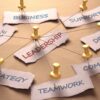An integrated HR strategy reconciles organizational goals, aligning processes, tools, and skills so that the organization can recruit and train talent that meets business goals. Leadership and HR must first agree what the culture is and take an in-depth look into their policies and strategies to determine if there is alignment amongst vision, direction, and perception. Here are integrated HR strategies to follow.
Define the difference between corporate and business strategy
Business strategy explores the question, “how do we gain a competitive advantage in the market?” while corporate strategy asks, “how do we fulfill stakeholder’s expectations?” When HR aligns with business strategy, it boosts employee performance by increasing employee satisfaction through programs that improve their decision-making power. Employees that are empowered by knowing they have more influence in business decisions tend to be more engaged and, therefore, more productive. And when HR gets involved in corporate strategy, it creates universal buy-in and moves in lockstep with the rest of the organization.
Hire people who fit the company culture
Have you created a company culture with your ideal customer in mind? Employees that align with your desired customers are the ones that will relate most to their needs, wants, and pain points. This is not to say that you should only hire people who resemble your buyer persona; diversity and inclusion are still key to successful work environments. However, recruit with culture in mind. Look beyond technical skills to attract talent that understand the needs of your customers and stakeholders.
Leverage technical competencies with culture in mind
Technical skills and experience are only an advantage when the employee can contribute to the company culture. There should be a balance between technical skills and culture fit, so the competency is felt beyond the individual, but the effectiveness reaches an organizational level. Tech-savvy candidates need to also thrive as part of a structured team. When hiring for technical skills, ask the candidate questions that also assess soft skills, such as questions that describe their motivation, reaction to change, collaborative skills, and ability to think outside the box. It would also be good to ask about their ideal management style and company culture.
Align HR practices and policies with culture
Organizational structure, employee development, performance evaluations, and change management are the key areas HR focuses on because they are the most impacted by business shifts and disruption. An organization can’t move towards its goals efficiently and successfully when its culture and policies aren’t in harmony.
Unfortunately, many employees don’t behave and perform according to the organizational structure because these beliefs and values remain unspoken and unwritten. However, for practices and policies to influence individuals, they should be written, shared, and modeled by leadership. Culture is meant to set the tone for the work environment, engaging employees so that they recognize shared directives and values.
If you are interested in pursuing a conversation or need more information on the topic above, please let me know. There is never any cost for a discovery call which you can schedule right here: https://calendly.com/inscapegreg/intro
I look forward to chatting with you.









